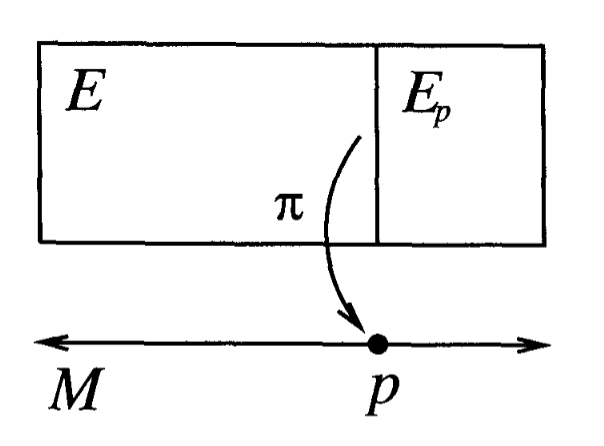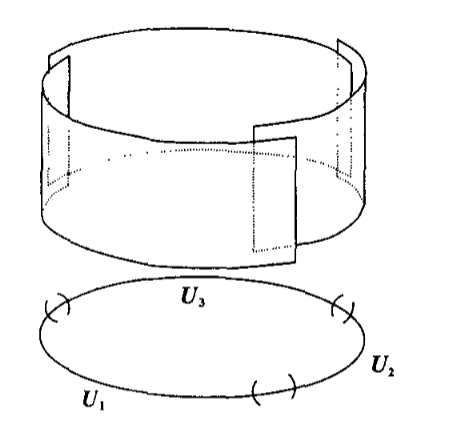21 Dec 2024
I’ve been trying to learn all about topological (quantum) field theories, the
cobordism hypothesis, and how to use
Along the way, I was watching a lecture by Jacob Lurie where he mentions something that should probably be obvious (but wasn’t to me):
For a (smooth) manifold
That is, given a manifold
I asked about this in the category theory zulip, and got some great responses that still took me a while to digest. Actually, it wasn’t until I started reviewing a bunch of material on principal bundles1 that everything clicked into place for me.
Over the course of this post, I’ll hopefully make this bijection obvious, and I’ll explain some facts about bundles along the way. This should serve as a nice quick blog post to write during my winter break since I’ve been extremely stressed for the last two months trying to get all my postdoc applications done2. Thankfully it’s all finally behind me, and I’m back in New York with people I love, so I’m resting up and doing math again (which have both been fantastic for my mental health).
Let’s get to it!
First, let’s remember what a bundle even is. Say we have a base space

We say that
For a bundle to be locally trivial we don’t ask for it to literally be

We say that such a bundle is a Fibre Bundle with Fibre
Can we classify all fibre bundles with fibre
Let’s think about how we might do this from a conceptual point of view, and that will lead us to the answer in the title of this post. Then we’ll reinterpret that conceptual understanding in much more concrete language, and hopefully explain why people care so much about principal bundles at the same time!
If we put our type theory hats on5, then we want to think about a fibre
bundle as being a map from our base space
But what should a “space of all
Now it feels like we made a choice here, taking
and if we make “
We normally think of
The answer comes from the Associated Bundle Construction, which is
the reason to care about principal bundles at all! In a remarkably
strong sense, we can understand every “
Concretely, we might understand a fibre bundle by picking a
good open cover
If we want to answer a (local) question about the bundle, we can use one of
these
It turns out that more fundamental than the particular choice of
trivialization are the “transition maps”
Now if we want to answer questions corresponding to “bonus structure” on
our fibre, we need to make sure we only ever glue in a way that preserves
the answers to these questions. That is, instead of
For example, if our fibres are all
So it turns out the crucial data for a
Indeed, say we have the data of a
In this case our fibres are all
Concretely, how can we implement this bijection?
Well, given a
In the other direction, say we have a principal
It’s a cute exercise to check that these operations are inverse to each other!
Now. Where did we start, and where did we end? Well we can read on
wikipedia that
So using the obvious action of
Which is exactly what we were looking for!
In hindsight, I’m not sure whether the story involving a “space of all
I’m super happy to have finished this post in two days. I started writing it last night when I got to my friends’ house in New York, and I finished it this morning while they were addressing and signing a bunch of christmas cards. It’s good to be thinking and writing about math again after my two months of postdoc application hell, and I’m feeling SO comfortable and relaxed it’s just great to be around people I love.
I’m going to hopefully find time to finish writing a series on skein algebras, hall algebras, and fukaya categories (which is the topic of my thesis) in the next month or two. That will be great, because I have a TON of fascinating stuff to share ^_^.
As always, thanks for hanging out. Now more than ever stay safe, stay warm, and take care of each other. Nobody else is going to.

Also… wow I’m tall.
-
I’m trying to learn some gauge theory for other reasons ↩
-
For political reasons at UCR, it seems like none of the rising 6th years will get TA positions next year. Which means that me and a LOT of people in my cohort are having to graduate a year earlier than we planned, because like…. we need money to live, lol. We found this out in mid october, crucially after the NSF grant deadline, and only a month and a half before most postdoc applications were due.
I made it happen, but it’s been a really unpleasant two months. ↩
-
I want this to be a quick low effort post, so I’m going to shamelessly steal all my graphics from Baez and Muniain’s book Gauge Fields, Knots, and Gravity. ↩
-
In this situation we say our condition is “local on the base” or “local on the target” since we have a neighborhood
-
You could just as well put your moduli space hat on, if you’re more comfortable with that. One of the ↩
-
It’s reasonable to ask why this definition only gives us locally trivial bundles. The reason is that a homotopy class of a map from a contractible space to the “space of all
-
I got this argument from Kevin Carlson in the CT Zulip, from the same thread I linked earlier. ↩
-
Here, of course, we have to work
-
This is what “structure groups” are all about. I had half a mind to write up a longer thing explaining how structure groups work and why they correspond to structure on the fibre surviving to global structure on the bundle (especially because it was something that took me a while to understand)… But I also want this post to be done quickly, and I found myself wanting to draw a bunch of pictures and write a bunch of stuff about that, so… I didn’t 😌.
I’m sure we’ll talk more about it someday. ↩
-
If at this point you’re thinking that if we don’t want to preserve ~any~ bonus structure we should take our structure group to be the whole of
-
I won’t get into this here, and since I want this to be quick I don’t want to find a good reference, but this use of the word “cocycle” isn’t an accident, and indeed we’re computing the Čech cohomology of the base space with coefficients in
-
It’s kind of hilarious how similar his blog looks to mine. We’re using very similar color schemes. ↩
-
Note also that the action of left multiplication of
So we have two bundles, one with a global right